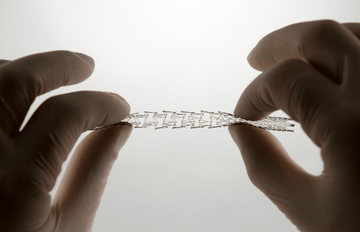Dyslipidemia, a disorder of lipid metabolism, is a worldwide health problem. Dyslipidemia is closely related to the development of cardiovascular disease, which is one of the most common causes of death. Indeed, elevated cholesterol levels, particularly LDL cholesterol, can contribute to the formation of atherosclerotic plaques in blood vessels and heart attacks or strokes. This article looks closely at the causes of dyslipidemia and the link between cholesterol and cardiovascular disease. We will also focus on the importance of prevention and which supplements can help fight dyslipidemia.
Article at a glanc:
- What is cholesterol?
- The link between cholesterol and cardiovascular disease
- Causes of dyslipidemia
- Diagnostics
- How to address elevated cholesterol levels?
- Which supplements could help in the case of dyslipidemia?
What is cholesterol?
Cholesterol is a fatty substance that occurs naturally in our bodies. It is a vital molecule found in every one of our cells, where it forms part of the cell membranes. Cholesterol is also a precursor to the synthesis of steroid hormones - not only are sex hormones (for example, testosterone, estrogens, and progesterone) formed from cholesterol, but also the stress hormone cortisol. The largest proportion of cholesterol is used to synthesize bile acids, which help digest fats. Last but not least, vitamin D is formed in the skin from cholesterol thanks to sunlight.
The body produces most cholesterol, but a smaller proportion (about 20%) is also taken in through the diet. Both dietary cholesterol and cholesterol synthesized by our bodies are transported in lipoprotein particles (complexes of lipids and proteins), which carry fats insoluble in the blood plasma. The four main groups of lipoproteins are:
- Chylomicrons are formed in the small intestine and deliver energy-rich fats from food to muscles or store them in fat cells. Chylomicrons also transport cholesterol from the intestines to the liver.
- VLDL (very low-density lipoprotein) transports lipids—triglycerides, phospholipids, and cholesterol—from the liver to fat cells.
- LDL (low-density lipoprotein, commonly called "bad cholesterol") transports cholesterol into the tissues. It can also be transported into the arterial walls, contributing to atherosclerosis and cardiovascular disease. LDL particles contain apolipoprotein B100 (Apo-B100).
- HDL (high-density lipoprotein, often called "good cholesterol") transports cholesterol from the tissues back to the liver. Cholesterol in the liver can be reprocessed and/or excreted from the body as bile salts. The transfer of cholesterol from the tissues to the liver is called reverse cholesterol transport. HDL particles contain apolipoprotein B (Apo-A).
The link between cholesterol and cardiovascular disease
The synthesis and utilization of cholesterol must be regulated to prevent its excessive accumulation and deposition in the body. The abnormal cholesterol and LDL particles deposition in the coronary arteries is significant. This deposition can lead to atherosclerosis, which is a major contributing factor to coronary artery disease. [1]
It should be noted, however, that metabolic processes such as oxidation or glycation play an important role in how damaging LDL particles can be to the endothelial cells of the arteries (and thus contribute to the development of atherosclerosis). Free radicals cause oxidative damage to LDL particles, and during glycation, the sugar molecule LDL changes its structure to form glycated LDL particles. Glycation of LDL, which is dependent on blood sugar concentration, may play a direct role in the development of atherosclerosis and make the LDL molecule more susceptible to oxidation. [2]
Thus, elevated LDL levels do not threaten endothelial cells directly, but they do mean that there are more LDL particles available to oxidize (or otherwise modify), which are then more likely to lead to blood vessel damage.
Causes of dyslipidemia
Primary dyslipidemia includes genetically determined disorders of lipid metabolism, such as familial hypercholesterolemia, familial hypertriacylglycerolemia, or familial hyperlipoproteinemia. These genetic disorders are among the most common inherited diseases and affect approximately 1 in every 500 people. [3]
The problem in familial hypercholesterolemia is a defect in the liver's LDL cholesterol receptor. Normally, a liver cell receives LDL cholesterol that binds to the LDL receptor, and the liver gets a signal to stop producing cholesterol. In familial hypercholesterolemia, damage to the LDL receptor results in the liver not getting the message to stop making cholesterol. Damage to the LDL receptor also occurs commonly in aging and some diseases (most notably diabetes mellitus).
Cholesterol levels tend to increase with age. In addition, a diet high in saturated fat and cholesterol reduces the number of LDL receptors. This also reduces the feedback mechanism that tells the liver cell to reduce cholesterol synthesis. [3]
Secondary dyslipidemia may result from another disease, such as diabetes mellitus, liver, biliary tract, kidney, or thyroid dysfunction. For this reason, it is advisable that patients with dyslipidemia also have their thyroid function investigated. [4] Over 90% of hypothyroid patients have dyslipidemia, but only about 4% of people with dyslipidemia have hypothyroidism. [5]
Dyslipidemia can also arise due to lifestyle factors such as excessive alcohol consumption, obesity but also infectious diseases. In the case of bacterial or viral infection, triglyceride concentrations usually increase. Therefore, lipid profile testing is not appropriate shortly after an infectious disease. It is recommended to perform a lipidogram about three weeks after a milder illness and about three months after a more severe illness. [6]
Diagnostics
Dyslipidemia is often detected at a preventive examination based on the results of blood tests when the patient's lipidogram is determined. It is advisable to monitor the lipid profile regularly in patients who have a family history of inherited disorders of lipid metabolism and in patients at higher risk for cardiovascular disease. The basic examination is the determination of total, LDL, and HDL cholesterol and triglycerides.
Other markers should also be tested for dyslipidemia. One of these markers, for example, is Apolipoprotein B. Apolipoproteins are the protein components of lipoproteins, and Apo-B is a marker of the number of all atherogenic lipoprotein particles in circulation. Many studies in the recent past have shown that elevated Apo-B levels are a better predictor of cardiovascular disease risk than the traditional markers mentioned above. [7] Therefore, many expert groups recommend the determination of Apo-B to assess cardiovascular risk. [11]
Another helpful marker is C-reactive protein (CRP) produced by the liver, which assesses inflammation or infectious disease. The development of atherosclerosis is associated with inflammation in the vessel walls, so the level of hs-CRP may indicate the risk of developing cardiovascular disease. CRP has been shown to correlate with the extent of atherosclerosis, and elevated triglyceride levels and BMI are closely associated with high CRP levels in patients with dyslipidemia. [8]
How to address elevated cholesterol levels?
Non-pharmacological measures are the mainstay of treatment for dyslipidemia. These include, in particular, regular physical activity, optimization of body weight (BMI 20-25 kg/m2, waist circumference < 94 cm in men and < 80 cm in women), elimination of smoking, limitation of alcohol consumption, and prevention or compensation of stress. Of course, dietary modification emphasizing a Mediterranean-type diet is also a critical factor in managing dyslipidemia.
Which supplements could help in the case of dyslipidemia?
Several strategies can be recommended to support the treatment of dyslipidemia. However, neglecting essential nutritional factors can lead to elevated blood lipid levels. We have, therefore, selected the following key supplements from our portfolio to focus on in the case of dyslipidemia.
Omega-3 fatty acids
Increased intake of omega-3 fatty acids is anti-inflammatory and helps maintain a healthy balance between omega-3 and omega-6 fatty acids. An imbalance between omega-3 and omega-6 fatty acids has been linked to various inflammatory diseases, including cardiovascular disease. Omega-3 fatty acids also have a beneficial effect on lipid and cholesterol metabolism. Ensuring sufficient omega-3 fatty acids is thus associated with a reduced risk of cardiovascular disease.
The Omega-3 Index is a useful measure of the amount of omega-3 fatty acids in the body. It is used as an independent risk factor for cardiovascular disease and is a valuable tool for assessing health status.
Magnesium
Magnesium is one of the frequently missing minerals in the human body. This element is indispensable in the body for all the reactions in which energy is formed, and its deficiency is thus manifested, for example, by fatigue. Magnesium is also depleted to an excessive degree during periods of increased stress (both mental and physical). However, magnesium also regulates the enzyme HMG-CoA reductase, which affects cholesterol metabolism (the same enzyme targeted by statins). Thus, magnesium deficiency can contribute to elevated cholesterol and negatively impact the formation of atherosclerotic plaques.
Vitamin E
Vitamin E is an important antioxidant, improves cell sensitivity to insulin, and reduces oxidative damage to LDL particles and excessive platelet aggregation. Vitamin E is the name for a group of eight forms of compounds - four tocopherols (alpha, beta, gamma, and delta) and four tocotrienols (alpha, beta, gamma and delta). The full spectrum vitamin E and tocotrienols found in ProLife have several health benefits over alpha-tocopherol alone. Tocotrienols block the enzyme HMG-CoA reductase, thereby suppressing cholesterol production in the body and helping to lower cholesterol. [9]
Vitamin D
Studies have shown that vitamin D deficiency is associated with a higher risk of cardiovascular disease and other risk factors such as dyslipidemia, hypertension, and diabetes. [10] Every cell in the body has a receptor for vitamin D, which shows its importance.
It is advisable to measure vitamin D levels and then personalize supplementation based on the results. You can use our home Vitamin D Level test kit to find out if you have enough of this key vitamin without having to go to a testing center.

Sources:
[1] Cholesterol: Synthesis, Metabolism, and Regulation, The Medical Biochemistry Page
(https://themedicalbiochemistrypage.org/cholesterol-synthesis-metabolism-and-regulation/)
[2] Fournet M, Bonté F, Desmoulière A. Glycation Damage: A Possible Hub for Major Pathophysiological Disorders and Aging. Aging Dis. 2018 Oct 1;9(5):880-900. doi: 10.14336/AD.2017.1121. PMID: 30271665; PMCID: PMC6147582.
[3] Pizzorno Joseph E., Murray Michael T., Textbook of Natural Medicine, 2 Volume Set. Fifth Edition, Elsevier. 2021
[4] Rizos CV, Elisaf MS, Liberopoulos EN. Effects of thyroid dysfunction on lipid profile. Open Cardiovasc Med J. 2011;5:76-84. doi: 10.2174/1874192401105010076. Epub 2011 Feb 24. PMID: 21660244; PMCID: PMC3109527.
[5] Šatný M., Vrablík, M. Sekundární dyslipidemie – přehled pro praktické lékaře. (https://www.medicinapropraxi.cz/pdfs/med/2019/05/11.pdf)
[6] Soška V., Sekundární dyslipidemie a jejich léčba. (https://www.casopisvnitrnilekarstvi.cz/pdfs/vnl/2007/04/14.pdf)
[7] Feingold KR. Introduction to Lipids and Lipoproteins. [Updated 2021 Jan 19]. In: Feingold KR, Anawalt B, Blackman MR, et al., editors. Endotext [Internet]. South Dartmouth (MA): MDText.com, Inc.; 2000-. Available from: https://www.ncbi.nlm.nih.gov/books/NBK305896/
[8] Swastini DA, Wiryanthini IAD, Ariastuti NLP, Muliantara A. Atherosclerosis Prediction with High Sensitivity C-Reactive Protein (hs-CRP) and Related Risk Factor in Patient with Dyslipidemia. Open Access Maced J Med Sci. 2019 Nov 14;7(22):3887-3890. doi: 10.3889/oamjms.2019.526. PMID: 32127998; PMCID: PMC7048367.
[9] Baliarsingh S, Beg ZH, Ahmad J. The therapeutic impacts of tocotrienols in type 2 diabetic patients with hyperlipidemia. Atherosclerosis. 2005 Oct;182(2):367-74. doi: 10.1016/j.atherosclerosis.2005.02.020. Epub 2005 Apr 20. PMID: 16159610.
[10] Kim MR, Jeong SJ. Relationship between Vitamin D Level and Lipid Profile in Non-Obese Children. Metabolites. 2019 Jun 30;9(7):125. doi: 10.3390/metabo9070125. PMID: 31262034; PMCID: PMC6680594.
[11] Contois JH, McConnell JP, Sethi AA, Csako G, Devaraj S, Hoefner DM, Warnick GR; AACC Lipoproteins and Vascular Diseases Division Working Group on Best Practices. Apolipoprotein B and cardiovascular disease risk: position statement from the AACC Lipoproteins and Vascular Diseases Division Working Group on Best Practices. Clin Chem. 2009 Mar;55(3):407-19. doi: 10.1373/clinchem.2008.118356. Epub 2009 Jan 23. PMID: 19168552.

















